
By Sean Gray
Over the past few years, we have seen some fierce debates on fire attack. These debates are healthy; if you look at the details, we are all working toward a common goal: extinguishing the fire. There are many ways to extinguish fire. Our goal should be to do it in the fastest and most efficient way possible. When done in a timely manner, it increases survivability for the possible victims and safety for firefighters and decreases property damage. Remember that we were sworn to save lives and property.

(1) This fog stream would block the exhausting smoke and fire. (Photos by author.)
It appears that a straight stream or solid stream has become the stream of choice because of what we’ve learned from firefighter safety research. We cannot push fire with water! What does that mean exactly? Fire gases can be moved and pushed by air from a hose stream, which is also known as “air entrainment.” It’s important to note that a fog stream has more cubic feet per minute (cfm) of air behind it than a straight stream. However, straight streams can still move a significant amount of air depending on the amount of nozzle movement. Fog streams and straight streams can push steam and gases. When used incorrectly during exterior attack through a window, the stream can overcome the exhaust outlet of the fire and change the flow path (photos 1-3).
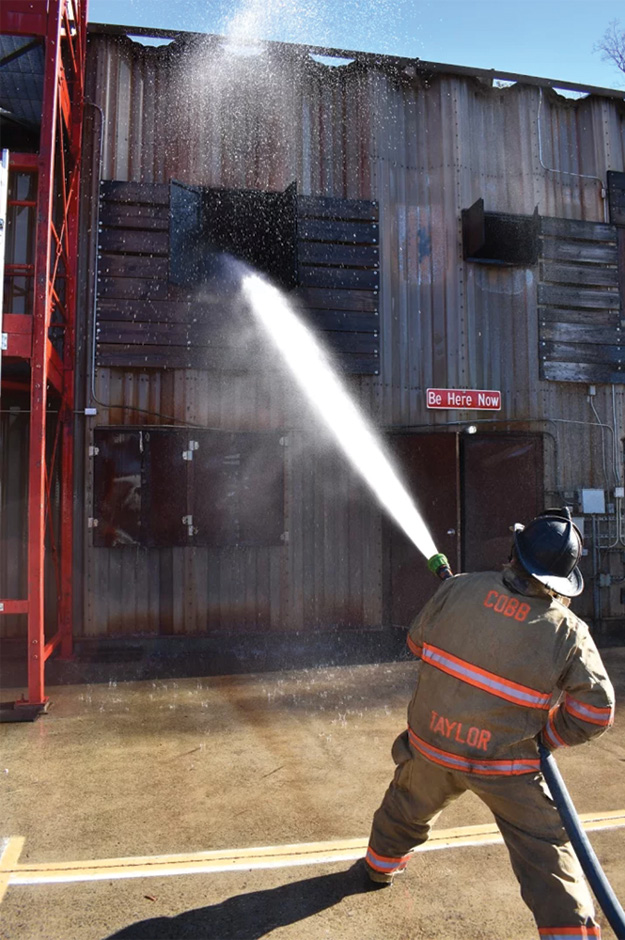
(2) Because this firefighter is standing too far away from the building, the stream is not at the proper angle for stream distribution. The water droplets are missing the portion of the room closest to the window.
We typically are not taught exactly where to place our hose streams. As technology in nozzles continues to advance, the focus seems to be on the amount of water being delivered combined with the lowest tip pressure instead of how it is being delivered. I’m not saying that flow rate and tip pounds per square inch (psi) aren’t important. It’s essential to have the proper nozzle flow and pressure matched with your hose type and size. I’m not arguing smooth bore vs. fog nozzles. The focus is on what we do with our straight or solid hose stream.
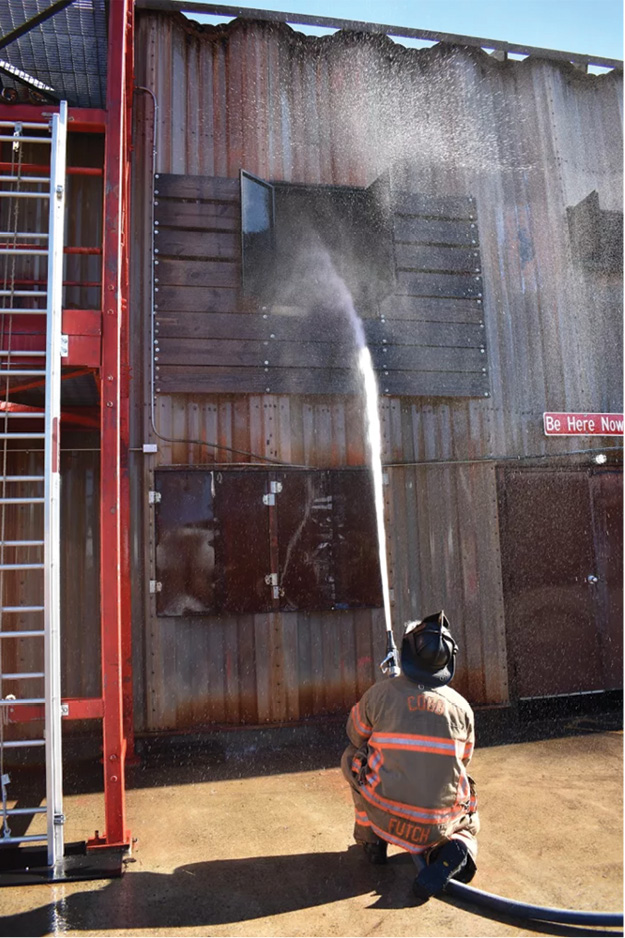
(3) A straight stream whipped in a circular fashion could also block the exhausting smoke and fire.
In the recruit academy, we are taught to apply the stream in the shape of “T,” “Z,” or “O.” Is this really that effective? Why is it that our counterpart police officers spend countless hours focusing on hitting their intended targets and we teach our recruits the T-Z-O patterns because they’re in a textbook? Some fire service experts believe flowing as much water as possible as you move through a structure is the best option for killing the fire. I agree that it is essential to flow enough water to protect yourself and your fellow firefighters, but let’s take it a step further by striving to be masters of our craft and including hose stream target practice. We need to understand that our hose streams can affect flow paths and push products of combustion into places where we don’t want them.
Air Entrainment
Movement of the nozzle is critical because of the air entrainment that can be created by rapidly moving or whipping the nozzle around. Studies have shown that even a smooth bore nozzle when moved rapidly in a circular fashion can create approximately 6,000 cfm of air movement. Air currents can push steam or gases onto potential victims. Understanding how much air a hose stream entrains will help you to use the hose stream more efficiently for its intended purpose.

(4) “Wall-ceiling-wall” is a stream application in the shape of a rainbow. It works well in hallways. It ultimately cools the surfaces and droplets will typically travel across the ceiling for the length of the hallway.
By applying the research with fireground experience and training, we have found that using a half-moon nozzle movement for interior fire attack works best—the half-moon shape toward the top of the wall; across the ceiling; and toward the opposite side, top of the wall at each turn inside the structure. This method is also known as the “wall-ceiling-wall technique.” The purpose of this technique is to cool the upper surfaces; minimize air entrainment; and decrease the disruption of the neutral plane, which leads us into what the water droplets do when they strike the surface (photo 4).
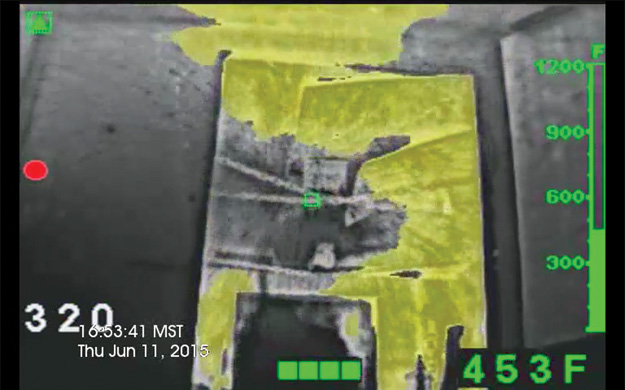
(5) Los Angeles County Fire Behavior Training examining what the stream does when it is applied to the ceiling.
Water Mapping
Water mapping hasn’t been discussed much in the past. The recent Underwriters Laboratories Firefighter Safety Research Institute (UL FSRI) fire attack research study determined that water droplets surf or travel across the ceiling and walls. It may appear that the droplets are banking off the ceiling and falling onto the burning fuels in the middle of the room; that is not the case. Very little water lands in the middle of the room. Again, the water travels across the ceiling and fans out toward the walls, coating the wall surfaces with cool water, which in turn reduces temperatures and converts burning gases into cooler smoke (photo 6). Examining water droplets has been well researched, but we still have more to learn. Do we, for example, know what happens to water droplets once they strike the target?
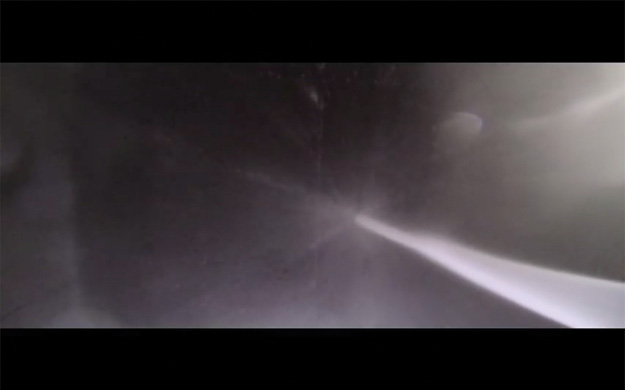
(6) Water surfing across the ceiling.
Cooling Surfaces
Let’s quickly review the basics: Large droplets penetrate through the smoke and gas layer until they strike an object or fall to the ground. Smaller droplets, according to their size, tend to turn to steam. The ideal water droplet size for gas cooling is 0.33 mm; unless you’re working in Europe or using a pressure washer to fight fire, you likely haven’t seen this size of droplet. There’s a science to gas cooling, and many firefighters outside of the United States have had success with this technique (photo 7). So, don’t hate it unless you’ve tried it.
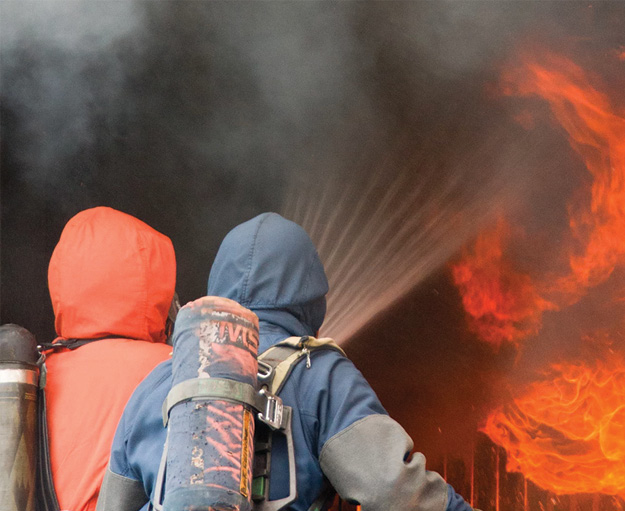
(7) Swedish firefighters performing gas cooling.
American firefighters are most familiar with surface cooling. My mentor and friend Charles Bailey from Montgomery County, Maryland, and I have had some long conversations on hose streams. He has repeatedly told me that we’re in the business of cooling surfaces to extinguish fires to allow us to rapidly search structures. We flow water onto a surface hoping to cool the overall environment as we make a push down the hallway. This, in turn, will cool the gases; if the surfaces are cooled, the gases will not be able to reach their ignition temperature.
We’ve skimmed over the science; let’s get to extinguishment. The consensus is to use straight streams, to forget about smooth bore vs. fog nozzles and focus instead on stream pattern. Why? Energy consumption, air movement, reach, and penetration. Air movement from the nozzle is important. Although research has shown that we can’t push fire with water, it is possible to push steam and gases with the air movement of the nozzle. It may seem complicated, but it’s simple. A droplet of water extinguishes flames, but the air from the nozzle can move gases and possibly ignite gases at a distance if the stream is not positioned on the base of the fire and if it has significant air movement behind it. If you are among those who swear they’ve seen fire pushed, I saw that, too, and I didn’t understand what I thought I was seeing until I read the fire research reports.
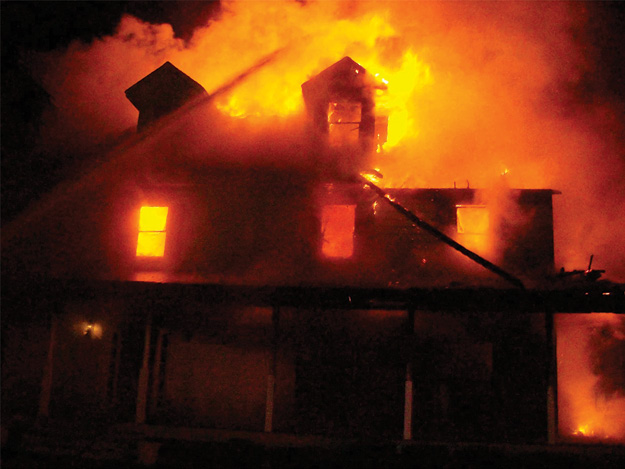
(8) Master streams through the flames do not work.
It’s no surprise that recent research has shown that getting water onto the fire as quickly as possible is the primary goal. It should not matter from which direction the water is coming, exterior or interior, above or below. With our nozzles, we can reach the fire from any direction. Let’s take a detailed look at how we can hit the target from all directions.
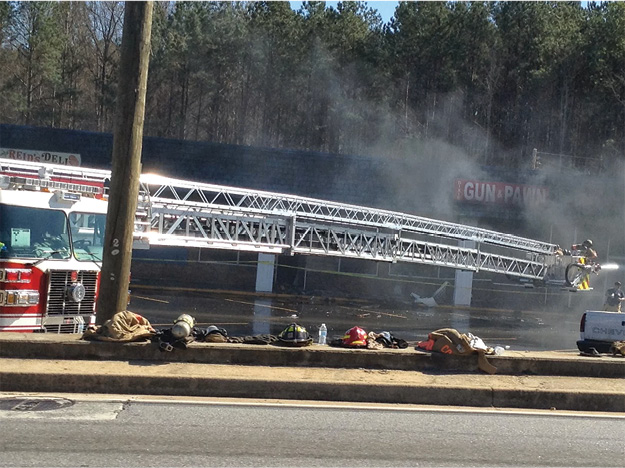
(9) The deck gun hitting the base of the fire = GOOD. Master streams up and in to cool the surfaces work well.
Hitting the Target
The master stream has been around since the Chicago Fire Department revolutionized the blitz attack. However, how many times have you seen a deck gun being flowed right through the flames and not actually hitting the base of the fire (photos 8-9)?
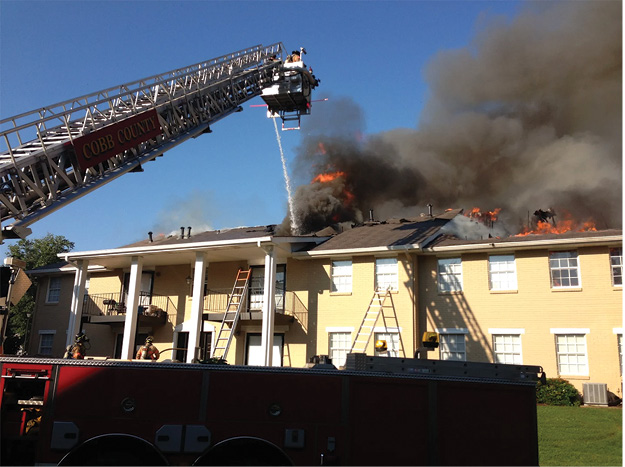
(10) Streams onto the roof do not reach the seat of the fire.
Master Stream from Above
This is typically used as a defensive position. Why do we see ladder trucks flowing water from above onto rooftop shingles? Have we forgotten that the roof was put there to keep out water? Sure, we can flow water into the holes where the fire may have burned through at times; that’s the only way to extinguish the fire. However, when we have buildings that have attic spaces or cocklofts, the fire is spreading laterally throughout that space. We should spread our hose streams laterally throughout the space to extinguish the fire (photos 10-11).

(11) The correct stream angle is important when using an exterior attack.
Upper-Floor Exterior Fire Attack
This technique has many names: transitional attack, softening the target, hit it hard from the yard, skeeting from the street, squirting from the dirt … the list goes on. Critics say it doesn’t take any technique or special knowledge to apply water from the exterior, but it’s quite the contrary. Exterior attack takes skill and precision. The firefighter must use a straight stream without much movement. Stream movement creates air entrainment, which could reverse the flow path and push steam or gases away from the outlet (i.e., the window) in which the stream is placed (photos 11-12).
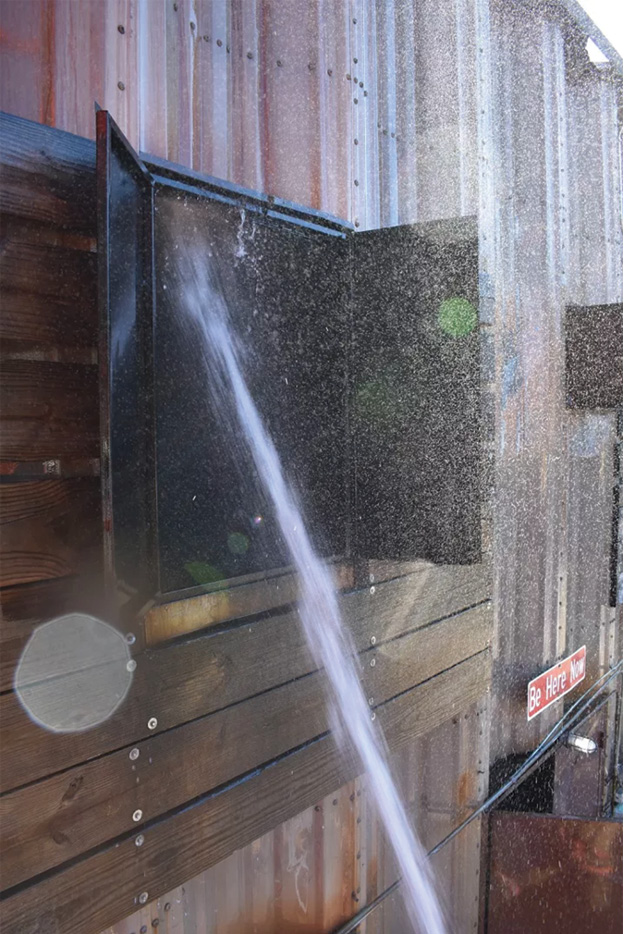
(12) The correct stream angle is important when using an exterior attack.
When and why should we flow water into a window from the exterior? The decision to flow water into a window is based on time. What can you do faster? If you see fire venting from an A-side window, what better way is there to keep the fire from growing than to apply water? You need to decide if you can reach the fire faster from the exterior or the interior. If exterior water application is possible, it must be done correctly so that the converted cooled gases can exit the window.
Flow water using a straight stream pointed at a steep angle at the ceiling. This allows the water to enter the structure and the cooled gases to exit from the same window. As the straight stream hits the ceiling, the droplets surf across the ceiling’s surface area. The stream also breaks apart, and the smaller droplets absorb the heat. The steam that generates during the cooling exits the window. It is critical to use a straight stream to allow the steam to exit from the window. Do not use a fog pattern. Using a fog pattern during an exterior attack can push steam and gases through the interior because of air entrainment. If a fog stream seals the entire window opening, the steam and gases on the interior will not be able to exhaust out of the window. This could collapse the neutral plane and make things worse for possible victims and firefighters on the interior. Coordinate an exterior attack with the crews in the interior. This is not a defensive tactic. You are quickly applying water to reset the fire and, therefore, lowering interior temperatures. Arguably, with the fire knocked down, the decreased temperatures will enable the interior attack and search crews to move faster to the base of the fire and find possible victims.
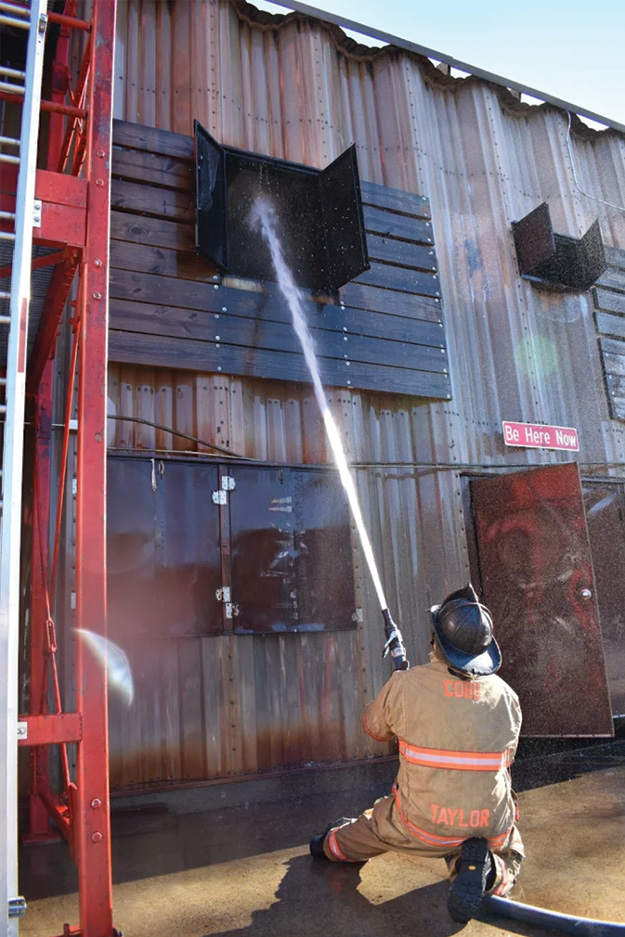
(13) The proper technique for exterior attack is just as important as it is for interior attack.
Following is the proper technique for an exterior attack:
• Apply the straight stream pattern at a steep angle.
• Keep the stream close to the sill.
• Aim the stream at the ceiling.
• Apply short bursts of water while recognizing the fire/smoke conditions.
Upper floors depend on stream reach. It is possible to get water into a third-floor window with a 1¾-inch hoseline, which will be sufficient in most areas of the United States.
Place the stream close to the window sill (photo 13), hitting the ceiling; the stream will fan across the room, cooling the surfaces. The stream will appear to be falling as a sprinkler head; in actuality, the water droplets are traveling or surfing across the surface and down the walls. Place the stream in the window, and leave it there without moving it. If there are multiple windows, flow water into one window until the fire darkens down; then move the stream to the next window. Using the thermal imaging camera (TIC) equipped with a temperature scale will make it easier for you to make an assessment. Flow enough water into each window to reset the flashover and cool the environment. Keep in mind that this technique of water application will not completely extinguish the fire. It resets the clock and makes the interior environment safer for victims and firefighters. Once the attack crew recognizes the flashover clock has been reset, they must immediately transition the line to the interior or communicate with other crews that already may be entering the structure. There is a chance for the fire to regrow; therefore, perform the interior attack immediately after the exterior attack.
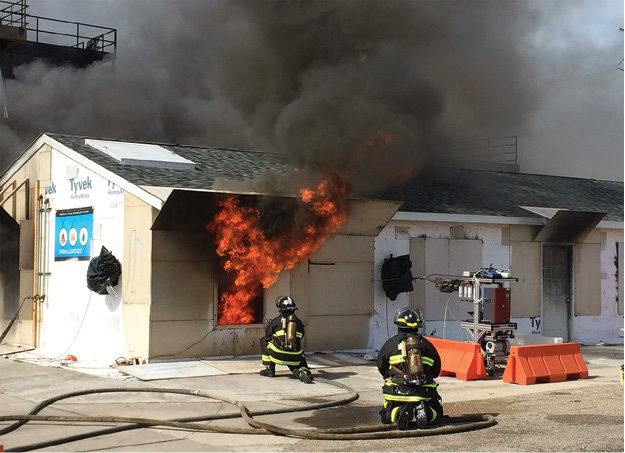
(14) Hit it from the exterior and transition to the interior.
Ground-Floor Exterior Attack
View the exterior attack as an action of opportunity. If fire is showing from a window and a hose stream can easily be placed in the window, take the opportunity. Applying water on the ground floor is the same as for the upper floor except that you may have to squat to get an exterior stream placed correctly (photo 14). Once the fire is knocked down, you may be able to sweep inside the window to get water directly on the base of the fire instead of just on the ceiling. This will take away any concerns for fire regrowth from the exterior attack. Again, this is an action of opportunity, and its use depends on the size-up of the first-arriving officer.
If a steam blast from an exterior stream has ever come down on you while you were operating on the interior, you know it’s not a good feeling and it hurts! Did you ask what type of stream was being applied? Is it possible that the hose stream was misapplied and uncoordinated? The science on pushing fire isn’t wrong; it’s that the science has been misinterpreted. We have all been guilty of making wrong assumptions. Because of research findings, we need to find the middle ground on tactics relative to many of the assumptions and decisions made on today’s fireground. Some in the fire service are creating policies and making decisions based on their interpretation of the firefighter safety research. Although it is good that departments want to be proactive, implementing policies and procedures without a solid understanding of fire dynamics and firefighter safety research is not the best practice. The research results are released in online educational courses, and they are summarized with “tactical considerations”—that’s right, considerations, not policies. There aren’t many scenarios on our evolving firegrounds that we can classify with the absolutes “never” and “always.”
Hitting our target and cooling surfaces are the goals during fire attack. It doesn’t take a lot of water when the stream is applied correctly from an efficient and effective place on the fireground. This topic demonstrates why we should be perpetual students of the fire service. There is so much information out there, we just have to be willing to go get it. Every day is a training day.
Bibliography
Knapp, J, Pillsworth, T, White, SP. “Nozzle Tests Prove Fireground Realities.” Fire Engineering. February 2003, 71–80.
Underwriters Laboratories Firefighter Safety Research Institute (UL-FSRI) Water Mapping Video; https://vimeo.com/153147874.
UL-FSRI Air Entrainment Video; https://vimeo.com/146163946.
Sean Gray is a lieutenant with Cobb County (GA) Fire and Emergency Services and has been in the fire service since 1993. He has a bachelor’s degree in fire safety engineering and is pursuing further studies. He has been a member of multiple technical panels involving firefighter safety research and is an appointed member of the Underwriters Laboratories Firefighter Safety Research Institute advisory board. He is a National Fire Protection Association committee member for Fire Hose and Fire Service Training Facilities. He recently co-authored The Evolving Fireground DVD and book (Fire Engineering). He has been published in multiple fire service magazines, is an FDIC International H.O.T. lead instructor, runs the Web site stopbelievingstartknowing.com, and delivers evidence-based tactics training classes across the United States.

